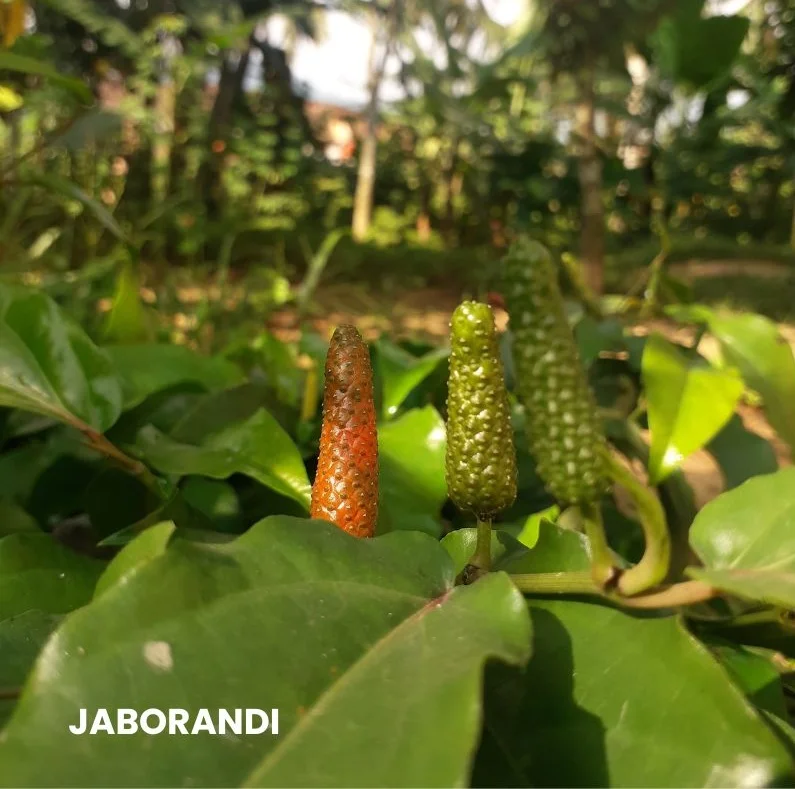Jaborandi, derived from the plant Pilocarpus microphyllus, is renowned for its potent glandular stimulation properties.
It is widely recognized as the most efficient diaphoretic, promoting heavy sweating and salivation.
This remedy is particularly effective in addressing abnormal sweats and night-sweats, especially in consumptive individuals (those suffering from tuberculosis).

SOURCE INFORMATION
Scientific Classification
- Family: Rutaceae
- Genus: Pilocarpus
- Species: P. microphyllus
Origin
- Jaborandi is native to the tropical rainforests of South America, primarily found in Brazil.
- The name “Jaborandi” is derived from the Tupi-Guarani language, meaning “slobber mouth,” a reference to the profuse salivation it induces.
Historical Facts
- Traditional Use: Indigenous tribes in South America have used Jaborandi for centuries to induce sweating and treat various ailments.
- Medical Use: Pilocarpine, the active alkaloid in Jaborandi, was isolated in the 19th century and has since been used in modern medicine, particularly for its diaphoretic and miotic effects.
DRUG PATHOGENESIS
- Jaborandi stimulates the autonomic nervous system, leading to increased glandular activity.
- This results in significant diaphoresis (sweating), salivation, and myosis (pupil constriction).
- Its action on the thyroid gland may contribute to its sweat-inducing effects.
KEY CHARACTERISTICS
- Diaphoresis: Profuse sweating from all parts of the body.
- Salivation: Excessive production of saliva.
- Myosis: Constriction of pupils.
- Heat and Flushing: Flushing of the face, ears, and neck shortly after administration.
DETAILED ORGAN SYMPTOMS
MIND
- Anxiety: Nervousness and tremors.
HEAD
- Vertigo: Dizziness, especially after using eyes.
- Headache: Associated with eye strain and use.
EYES
- Eye Strain: Irritability and tiredness of the ciliary muscle.
- Burning Sensation: Heat and burning in the eyes.
- Visual Disturbances: Hazy vision, indistinct vision, and white spots.
- Smarting Pain: Pain and smarting sensation in the eyes.
EARS
- Tinnitus: Ringing or buzzing in the ears.
- Serous Exudation: Fluid buildup in the tympanic cavities.
MOUTH
- Salivation: Free and excessive salivation, with saliva being viscid and egg-white-like.
- Dryness: Dry mouth before the onset of salivation.
STOMACH
- Nausea: Triggered by looking at moving objects.
- Vomiting: Accompanied by pressure and pain in the stomach.
ABDOMEN
- Diarrhea: Painless diarrhea during the day, often with flushed face and profuse sweating.
URINARY
- Scanty Urine: Reduced urine output with pain over the pubic area and frequent urging.
HEART
- Pulse Irregularity: Irregular, dicrotic pulse.
- Chest Oppression: Sensation of pressure in the chest.
- Cyanosis: Bluish discoloration of the skin due to lack of oxygen.
- Nervous Cardiac Affections: Cardiac symptoms related to nervous system issues.
RESPIRATORY
- Bronchial Irritation: Inflammation of the bronchial mucous membrane.
- Cough: Inclination to cough with difficulty breathing.
- Pulmonary Edema: Fluid accumulation in the lungs.
- Foamy Sputum: Thin, serous expectoration.
- Slow Respiration: Slow, sighing breaths.
SKIN
- Excessive Sweating: Profuse perspiration from all parts of the body.
- Dry Skin: Persistent dryness of the skin.
- Eczema: Dry eczema with semi-lateral sweats and chilliness.
RELATIONSHIP WITH OTHER DRUGS
Compare
- Amyl Nitrite: Used for similar diaphoretic effects and to relieve acute angina.
- Atropine: An antagonist to Pilocarpine, used to counteract its effects; Atropine in doses of one one-hundredth grain for one-sixth of Pilocarpine.
- Physostigma: For nervous and glandular affections.
- Lycopodium: For digestive and respiratory issues.
- Ruta: For eye strain and visual disturbances.
Pilocarpin Mur
- Used in conditions such as Meniere’s disease and rapidly progressive phthisis with free hemorrhages and profuse sweating.
- The 2x trituration of Pilocarpin Mur is particularly indicated.
DOSE
Homeopathic Uses
- Third Potency: Standard homeopathic dilution.
Non-Homeopathic Uses
Powerful and Rapid Diaphoretic
- Primarily used in conditions requiring rapid and intense sweating.
- Renal Disease: Particularly effective in managing renal conditions with uraemia by eliminating both water and urea.
- Scarlatinal Dropsy: Used to manage oedema following scarlet fever.
Contraindications
- Heart Failure: Not recommended for patients with cardiac issues.
- Post-Puerperal Uremia: Should be avoided in post-childbirth uremia.
- Elderly Patients: Contraindicated in senile cases due to potential complications.
DOSE
- Hypodermic Administration: One-eighth to one-fourth grain for rapid diaphoretic action.
Frequently Asked Questions
What is Jaborandi used for?
- Jaborandi is used primarily for inducing sweating and salivation.
- It is effective in treating night-sweats in tuberculosis, eye strain, and respiratory conditions like bronchitis and whooping cough.
How is Jaborandi administered?
- In homeopathy, it is typically used in third potency dilutions.
- In conventional medicine, it may be administered hypodermically in specific doses for diaphoretic effects.
Meaning of Difficult Words
- Diaphoretic: An agent that induces sweating.
- Myosis: Constriction of the pupils.
- Exophthalmic Goitre: A type of hyperthyroidism characterized by bulging eyes.
- Atrophic Choroiditis: Inflammation and atrophy of the choroid layer of the eye.
- Serous Exudation: Fluid leakage into body tissues or cavities.
- Ptyalism: Excessive salivation.
- Dicrotic Pulse: A pulse with a double beat.
- Cyanosis: Bluish discoloration of the skin due to lack of oxygen.
- Pulmonary Oedema: Fluid accumulation in the lungs.
- Uraemia: A condition involving abnormally high levels of waste products in the blood.
